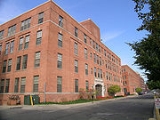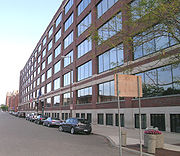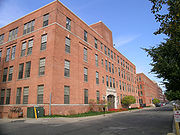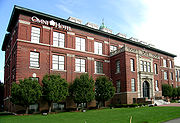
Parke-Davis and Company Pharmaceutical Company Plant
Encyclopedia
The historic River Place (also known as Stroh River Place) is located in Detroit, Michigan
, bounded by Joseph Campau Avenue, Wight Street, McDougal Avenue, and the Detroit International Riverfront
. It was formerly the Parke-Davis and Company Pharmaceutical Plant. The complex was listed on the National Register of Historic Places
in 1985.




moved to the riverfront property this complex now occupies. Between 1891 and 1955, the company expanded the complex to cover over 14 acres (5.7 ha), building the 26 buildings that still stand. These buildings were designed by some of the most prominent Detroit architects, including Donaldson & Meier, Albert Kahn, and Smith, Hinchman & Grylls. As a group, the buildings in the complex are significant as the represent a wide variety of industrial architecture from the early 20th century.
In 1979, Parke-Davis sold its property in Detroit, including the Research Laboratory, to the Stroh family (of Stroh Brewery Company
). The complex, now known as River Place, has been converted into offices, retail space, residences, and a hotel.
The most notable single building in this group is the Riverwalk Hotel Detroit, the former Parke-Davis Research Laboratory, built in 1902 along the Detroit River. This building was the first industrial research laboratory in the U.S. established for the specific purpose of conducting pharmacological research, inaugurating the commercial pure science approach which has driven the rapid development of pharmaceutical technology. The research laboratory was declared a National Historic Landmark
in 1976.
Michigan
Michigan is a U.S. state located in the Great Lakes Region of the United States of America. The name Michigan is the French form of the Ojibwa word mishigamaa, meaning "large water" or "large lake"....
, bounded by Joseph Campau Avenue, Wight Street, McDougal Avenue, and the Detroit International Riverfront
Detroit International Riverfront
The Detroit International Riverfront is an area of Detroit, Michigan that borders the Detroit River. The International Riverfront area extends from the Ambassador Bridge in the west to Belle Isle in the east, extending a total of 5½-miles and encompassing a multitude of parks, restaurants, retail...
. It was formerly the Parke-Davis and Company Pharmaceutical Plant. The complex was listed on the National Register of Historic Places
National Register of Historic Places
The National Register of Historic Places is the United States government's official list of districts, sites, buildings, structures, and objects deemed worthy of preservation...
in 1985.




History and significance
In the 1870s, Parke-DavisParke-Davis
Parke-Davis is a subsidiary of the pharmaceutical company Pfizer. Although no longer an independent corporation, it was once America's oldest and largest drug maker, and played an important role in medical history.- History :...
moved to the riverfront property this complex now occupies. Between 1891 and 1955, the company expanded the complex to cover over 14 acres (5.7 ha), building the 26 buildings that still stand. These buildings were designed by some of the most prominent Detroit architects, including Donaldson & Meier, Albert Kahn, and Smith, Hinchman & Grylls. As a group, the buildings in the complex are significant as the represent a wide variety of industrial architecture from the early 20th century.
In 1979, Parke-Davis sold its property in Detroit, including the Research Laboratory, to the Stroh family (of Stroh Brewery Company
Stroh Brewery Company
The Stroh Brewery Company was a beer brewery located in Detroit, Michigan. In addition to their own Stroh's brand, they produced or bought the rights to several other brands including Goebel, Schaefer, Schlitz, Augsburger, Erlanger, Lone Star, Old Milwaukee, Red River, and Signature, as well as...
). The complex, now known as River Place, has been converted into offices, retail space, residences, and a hotel.
Description
These buildings range from brick mill buildings built at the turn of the 20th century to reinforced concrete buildings constructed after 1920 and range from one to six stories in height. The central and northern portions of the complex are tightly packed with interconnected buildings. There is more open space at the southern edge along the river.The most notable single building in this group is the Riverwalk Hotel Detroit, the former Parke-Davis Research Laboratory, built in 1902 along the Detroit River. This building was the first industrial research laboratory in the U.S. established for the specific purpose of conducting pharmacological research, inaugurating the commercial pure science approach which has driven the rapid development of pharmaceutical technology. The research laboratory was declared a National Historic Landmark
National Historic Landmark
A National Historic Landmark is a building, site, structure, object, or district, that is officially recognized by the United States government for its historical significance...
in 1976.

